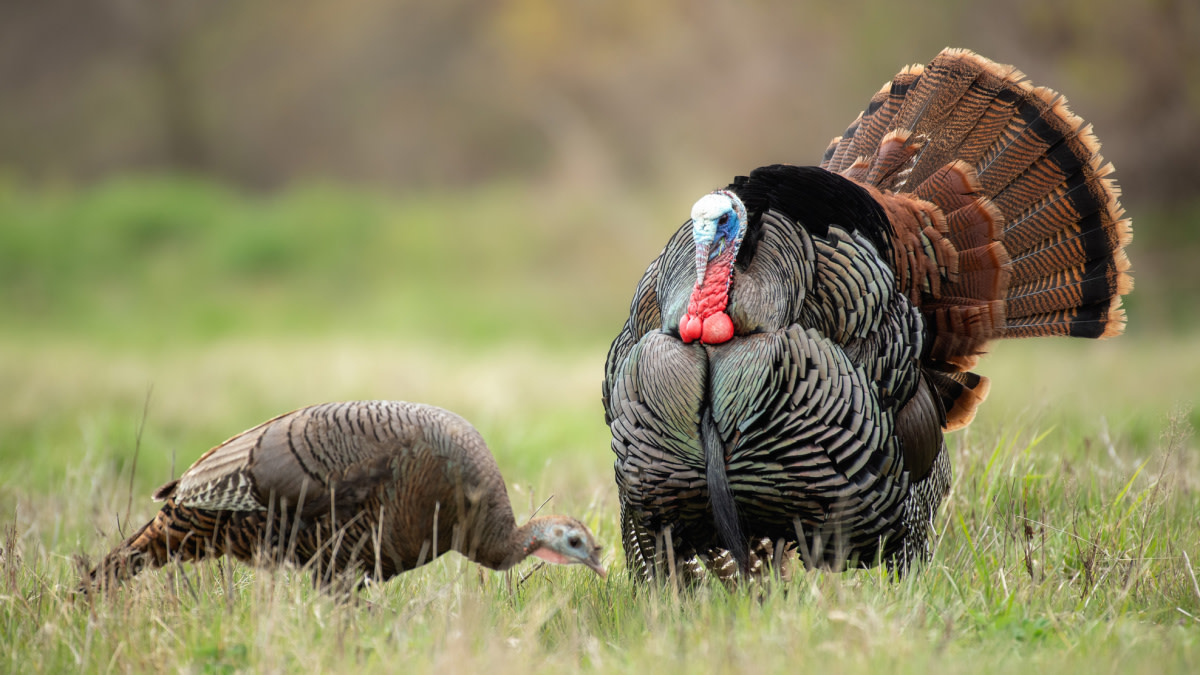
While a few memorable longbeards have left me in awe of their survival savvy, it’s easy to give that old tom more credit for higher thought than his pea-sized brain deserves. In retrospect, most of my missed opportunities transpired because I miscalculated the myopic focus driving his behavior in the breeding season. A turkey has but one thing on his mind in the spring, and your success in notching a tag involves thinking like the object of his affection.
Alas, the entire spring season starts and stops with the hen. If you aim to rest your bead on his bright red and white head, you should lock yourself in on those drab-colored divas of the forest. Investing in a fundamental understanding of their language, schedules, and menu will increase your odds of tagging a gobbler that’s already figured them out.
Walk the Talk Book chapters have been written on the particulars of turkey vocalizations. Clucks, purrs, and cackles all have meaning and context, but many spring hunters lure in a tom without full fluency in his love language. Success in calling focuses more on mimicry of the natural cues hens are providing than delivering that longbeard a heartfelt and grammatically-flawless sonnet. A mediocre caller who can read the room will tag more birds than a sweet talking pro speaking turkey out of turn.
If a particular hen acts territorial or annoyed at your calling, one-up her by channeling your inner Jolene. Most early season gobblers slip into gun range to simply check out the perceived cat fight over his attention. The wild turkey’s social hierarchy is well established but also constantly at risk for disruption. Early in the season, the presence of another, potentially more dominant hen that appears to be moving in on the flock doesn’t sit well with the leader. Mocking her complaints note for note–even if you’re not sure exactly what threats she’s hurling at you–will coax her and the tom in close to reestablish the pecking order.
Likewise, restraint and moderation are warranted when the woods mirror that tone. While the bark-splitting blast of a box call in late morning might elicit a distant shock gobble, real hens rarely communicate that way. Most natural turkey calling is soft and infrequent, and by mid-season most hens are no longer lighting up the woods each morning. Fewer still have to beg for a longbeard’s attention. He’ll be expecting the same from you.
If the flock is noisy, get noisier. Pinpoint what sounds from the ladies draw out a tom’s gobble and see if you can turn up his libido. Pulling a gobbler away from his hens presents a serious challenge, but I’ve been successful seducing fired up toms by keeping his mojo flowing as the ladies with him lose interest. Last season, I convinced a boss tom to ditch his flock of 20 or more hens about an hour after fly-down by keeping him fired up with strong cuts on the mouth call. A thousand gobbles later, his girlfriends turned their backs on him, and he walked in gun range in search of a Plan B. Even if he sticks with his hens, the commotion may pull in another distant gobbler that wants to size up the party.
Recon Around Resources Toms quickly learn where the ladies gather in spring. You should, too, if you want to narrow in on his patterns. Advanced degrees in wildlife ecology or botany aren’t required, but the natural curiosity and acknowledgement of their basic needs will serve you well. Her demands are not unlike ours. Food, shelter, and companionship keep flocks healthy and growing. Eastern hunters survey the hardwoods for last fall’s mast crop, while most of us in Rio or Merriams country target green slopes, new growth, and the protein-rich resources they provide. Scouting before and after each season is a worthwhile investment as the birds’ needs and Mother Nature’s offerings transition considerably over the course of the spring.
Toms love to cruise open areas surrounded by thick shelterbelts in search of a hen that requires his services. The cover provides hens quality nesting habitat and a place to flee his persistent harassment for some privacy in managing her clutch. One of my most productive hunting spots involves a lush creek traced along its length by a logging road. The adjacent hillside also offers a mix of open fields and stands of timber for shade and roosting. From a hen’s perspective, this place is the full package.
The toms cut trails in the logging road each spring as they make the rounds with the flock. As morning wears on, the ladies peel off to nest along the creek, allowing loneliness and testosterone-inspired behavior to supplant his otherwise risk-averse tendencies. Over the years, multiple generations of gobblers have fallen for the same subterfuge within 100 yards of that spot.
Phrases like “chess match” and “cat-and-mouse” have been used to describe this annual battle in the woods, and often for good reason. Gaining the upper hand on a seasoned spring longbeard relies on a hen-centric strategy sprinkled with a little good luck. Even when stacking the cards in their favor, experienced turkey hunters know that gobbler behavior is still routinely unpredictable and puzzling. No other beast in the forest shares his knack for going wildly off script during what likely began as a perfectly choreographed dance between predator and prey.
Feature image via Matt Hansen.






